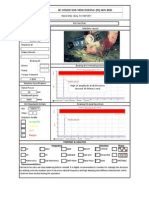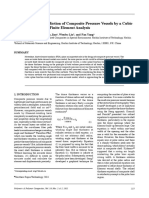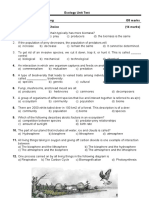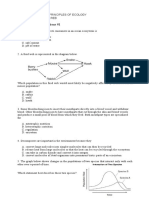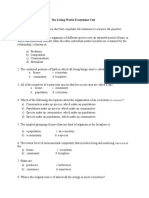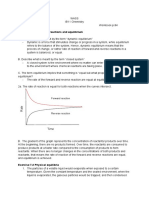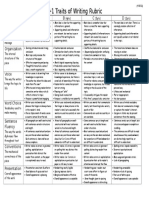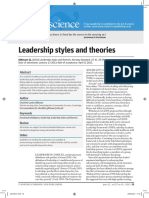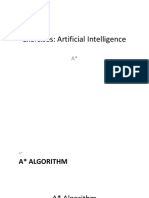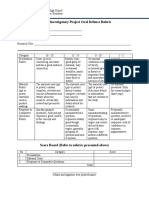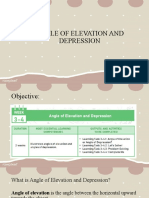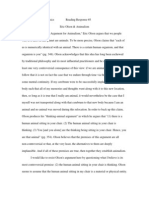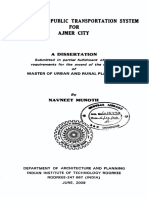Professional Documents
Culture Documents
Niche Partitioning
Niche Partitioning
Uploaded by
Khang LqOriginal Description:
Original Title
Copyright
Available Formats
Share this document
Did you find this document useful?
Is this content inappropriate?
Report this DocumentCopyright:
Available Formats
Niche Partitioning
Niche Partitioning
Uploaded by
Khang LqCopyright:
Available Formats
Niche Partitioning and
Species Coexistence Scientists at Work
Student Worksheet
OVERVIEW
This worksheet complements the short video “Niche Partitioning and Species Coexistence” from the Scientists at
Work series.
PROCEDURE
1. Prior to watching the film, read the questions below.
2. Watch the film.
3. If working with a partner or in a small group, discuss and answer the questions below. If working alone,
think about and answer the questions below.
QUESTIONS
1. List two pieces of evidence from the film justifying the claim that “termite mounds are an advantage to
the savanna ecosystem.”
- They concentrate nutrition and moisture.
- They enable the growth of trees.
2. Define the term niche:
A position in the habitat that the organism occupies
3. The film states that “Ecological theory predicts, ‘to coexist, each species must occupy a unique niche.’”
Based on your definition in the above question, explain this prediction in two sentences.
By having a unique niche, each species will not compete with each other for resources.
This would then allow them to coexist.
4. Technology has changed the way scientists do research. Provide three pieces of evidence from the film to
support the claim that “Technology is crucial for Dr. Pringle’s species coexistence research in Gorongosa
National Park.”
- They need technology to track the movement of the species through time.
- They can analyse the food source of the species
- They need access to technology to process their dat
5. Dr. Pringle states in the film, “Plant diversity and the presence of termite mounds help maintain large
mammal diversity.” Provide two pieces of evidence from the film (one about plant diversity and one about
termite mounds) to justify this claim.
The termite mounds diversity helps maintain plant diversity, which then provides diversity
for the mammals
Patterns and Processes in Ecology Revised September 2017
www.BioInteractive.org Page 1 of 3
Scientists at Work
Niche Partitioning and Species Coexistence Student Worksheet
6. Dr. Pringle is using DNA metabarcoding, summarized here:
a. Provide two reasons why it is important to isolate undigested plant cells.
So that the genetic information in the plant cells are preserved.
b. In order to use this DNA technique, the research team first collected DNA from 400 plant species that
grow on the African savanna and entered the sequence data into a database. Explain why this was a
necessary first step.
So they can mirror and compare the DNA sequences to match the sample with the
corresponding species.
7. Toward the end of the film, the narrator says, “The Pringle lab’s work reminds us that ecological
communities are profoundly interconnected.” Using sentences, describe three specific examples of the
interconnectedness of the organisms found in Gorongosa National Park.
Firstly, the three species that occupy their niche positions can coexist in the savannah.
Secondly, the marmites help maintain biodiversity for all other organisms.
8. Conservation biologists in other areas of the world think that knowing more about what wildlife eat will
help them make better decisions to protect threatened and endangered species. Explain two ways
conservationists could use DNA metabarcoding data to help make these decisions.
They could interfere with the food sources (plants) of the species, to ensure its availability
by growing more of it or prevent them from being drained. Secondly, they can set up a
new habitat that can offers the resources to those endagered species.
Patterns and Processes in Ecology Revised September 2017
www.BioInteractive.org Page 2 of 3
Scientists at Work
Niche Partitioning and Species Coexistence Student Worksheet
Plant Taxa Buffalo Cattle Impala The table to the left is from another metabarcoding
1 Hirpicium diffusum Yes Yes Yes study by Dr. Pringle. Use the table to complete a Venn
2 Gutenbergia (genus) Yes Yes Yes diagram illustrating the different plants eaten by
3 Emilia discifolia Yes Yes Yes three different animals. Label a circle for each of the
4 Osteospermum vaillantii No Yes Yes animals and then place a dot in the appropriate area
5 Helichrysum glumaceum No Yes Yes of the graph for each plant taxa.
6 Asteraceae (family) No No Yes
7 Eragrostis sp. Yes Yes No
8 Digitaria (genus) No Yes Yes
9 Tragus berteronianus No Yes Yes
10 Setaria sphacelata Yes No No
11 Eragrostis papposa No Yes No
12 Urochloa brachyura Yes No Yes
13 Echinochloa pyramidalis Yes No No
14 Harpachne schimperi Yes Yes Yes
15 Panicum maximum Yes Yes Yes
16 Garnotia (genus) Yes No No
17 Brachiaria eruciformis Yes No No
18 Sporobolus agrostoides Yes No No
19 Dinebra retroflexa No Yes No
20 Pennisetum hohenackeri Yes No No
Data from Kartzinel, et al. (2015). PNAS 112(26), 8019–8024.
9. Which two animals have the most overlap in their diets? Justify your response.
10. Cattle and buffalo share a similar fundamental niche, the entire set of conditions under which a
population can survive and reproduce. A realized niche is the set of conditions actually used by a given
population. Explain what the data in the Venn diagram suggest about the realized niches of the cattle
and buffalo and their ability to coexist. Use evidence to support your explanation.
11. If plant species #10, 13, 16, 17, 18, and 20 were no longer available to the buffalo, predict three
consequences to the stability of the biological communities and ecosystem.
Patterns and Processes in Ecology Revised September 2017
www.BioInteractive.org Page 3 of 3
You might also like
- Exercise 13 Worksheet: FaisanDocument4 pagesExercise 13 Worksheet: FaisanFrancesca FaisanNoch keine Bewertungen
- Photosynthesis-What's in A LeafDocument7 pagesPhotosynthesis-What's in A LeafMarvellous100% (1)
- Day 4. Warm-Up. STAAR® Blitz. Science. BiologyDocument2 pagesDay 4. Warm-Up. STAAR® Blitz. Science. BiologyRaul Ramirez RangelNoch keine Bewertungen
- Exploring Trophic Cascades - HHMI (Home Edition)Document3 pagesExploring Trophic Cascades - HHMI (Home Edition)Y Alton100% (1)
- Regulation - Lactase - Gene - Click - Learn - WorksheetDocument3 pagesRegulation - Lactase - Gene - Click - Learn - WorksheetSophia BrannemanNoch keine Bewertungen
- Succession PogilDocument6 pagesSuccession Pogilapi-28380143233% (3)
- Succession POGIL Answer KeyDocument1 pageSuccession POGIL Answer KeyNo NameNoch keine Bewertungen
- Final Exam Study Guide 7th Grade Life Science 2014Document3 pagesFinal Exam Study Guide 7th Grade Life Science 2014api-249710831Noch keine Bewertungen
- The Chemistry of Life ANSWER KEYDocument5 pagesThe Chemistry of Life ANSWER KEYAhmadnur JulNoch keine Bewertungen
- Chapter 3 The Biosphere Test ADocument7 pagesChapter 3 The Biosphere Test ATUTORKIMNoch keine Bewertungen
- Ontario Immigrant Nominee Program (OINP) Expression of Interest (EOI) Attestation FormDocument1 pageOntario Immigrant Nominee Program (OINP) Expression of Interest (EOI) Attestation FormDouglas Nespoli de MelloNoch keine Bewertungen
- IB Biology: Ecology Review (4.1-4.4) : NameDocument4 pagesIB Biology: Ecology Review (4.1-4.4) : NameINDRANI GOSWAMINoch keine Bewertungen
- MSDS Uni Paint Marker PX-20 2Document2 pagesMSDS Uni Paint Marker PX-20 2pitichai_p100% (2)
- Vibration Sample Template PDFDocument1 pageVibration Sample Template PDFnumanfawzal67% (3)
- Dome Thickness Prediction of Composite Pressure Vessels by A Cubic Spline Function and Finite Element Analysis - Wang2011Document8 pagesDome Thickness Prediction of Composite Pressure Vessels by A Cubic Spline Function and Finite Element Analysis - Wang2011Hiến Đinh VănNoch keine Bewertungen
- This Study Resource Was: Ecology Lab - Predator Prey InteractionsDocument6 pagesThis Study Resource Was: Ecology Lab - Predator Prey InteractionsSherlock HolmesNoch keine Bewertungen
- Food Chains and Food Webs DFDocument2 pagesFood Chains and Food Webs DFDomEnt AllureNoch keine Bewertungen
- Kami Export - Emily Moran - 26 Ecological Pyramids-SDocument6 pagesKami Export - Emily Moran - 26 Ecological Pyramids-SEmily MoranNoch keine Bewertungen
- Ecological Pyramids WorksheetDocument3 pagesEcological Pyramids Worksheetapi-26236818833% (3)
- Evolution Practice Test 2 With AnswersDocument10 pagesEvolution Practice Test 2 With AnswersSuhani SinhaNoch keine Bewertungen
- Ecological Pyramids WorksheetDocument5 pagesEcological Pyramids Worksheetace0% (1)
- Case Study - Invading Bullfrogs Part 1: What's in The Pond?: High MountainsDocument4 pagesCase Study - Invading Bullfrogs Part 1: What's in The Pond?: High Mountainsalissa arnoldNoch keine Bewertungen
- Category 5-Bonus PacketDocument11 pagesCategory 5-Bonus Packetapi-312542882Noch keine Bewertungen
- Ecology ExamDocument11 pagesEcology ExamSmit V. PatelNoch keine Bewertungen
- Practice Questions 1 Ecology ClickersDocument17 pagesPractice Questions 1 Ecology ClickersGiri Raj SinghNoch keine Bewertungen
- Characteristics of PopulationsDocument6 pagesCharacteristics of PopulationsAnn Marilette100% (2)
- 2 2 Carbon Cycle WorksheetDocument4 pages2 2 Carbon Cycle WorksheetVince HernándezNoch keine Bewertungen
- Online Interactive Population EcologyDocument2 pagesOnline Interactive Population EcologyJanine BertolottiNoch keine Bewertungen
- Ecology Lab - Predator Prey Interactions: NameDocument6 pagesEcology Lab - Predator Prey Interactions: NameOlivia SardinaNoch keine Bewertungen
- Characteristics of Life QuizDocument2 pagesCharacteristics of Life QuizRuth Danielle GasconNoch keine Bewertungen
- Directed Study - Day 2 - Pyramids Graphic OrganizerDocument2 pagesDirected Study - Day 2 - Pyramids Graphic Organizerapi-240119100Noch keine Bewertungen
- CSEC Biology Resit Test 1Document5 pagesCSEC Biology Resit Test 1ISLAND NATANYANoch keine Bewertungen
- Dichotomous Key PracticeDocument2 pagesDichotomous Key PracticeBioScMentor-1Noch keine Bewertungen
- Ecology WorksheetDocument12 pagesEcology WorksheetManongdo Allan0% (1)
- Types of Natural SelectionDocument2 pagesTypes of Natural SelectionRichard MohammedNoch keine Bewertungen
- Revision Sheet - Docx-2Document6 pagesRevision Sheet - Docx-2mofid monirNoch keine Bewertungen
- Chapter 2 Biology TestDocument9 pagesChapter 2 Biology Testhaaaaaay.Noch keine Bewertungen
- Kami Export - Cycles ActivityDocument9 pagesKami Export - Cycles ActivityEthan BompartNoch keine Bewertungen
- Worksheet - Patterns of InteractionsDocument4 pagesWorksheet - Patterns of InteractionsWilliam SilvérioNoch keine Bewertungen
- 26 Ecological Pyramids-SDocument6 pages26 Ecological Pyramids-Sapi-290419496100% (1)
- Jacob Gutierrez - Virtual Bioman PhotosynthesisDocument3 pagesJacob Gutierrez - Virtual Bioman PhotosynthesisJacob GutierrezNoch keine Bewertungen
- Speciation WorksheetDocument1 pageSpeciation WorksheetSusan Browne100% (1)
- Ecology Practice OSSDDocument3 pagesEcology Practice OSSDoc0% (1)
- Licensure Examination For Teachers Practice TestDocument29 pagesLicensure Examination For Teachers Practice Testapi-286466377100% (1)
- CHPT 15 Genetics Practice ProblemsDocument7 pagesCHPT 15 Genetics Practice ProblemsFatimah AliyaNoch keine Bewertungen
- Evolution Study Guide Answer Key - Verona School DistrictDocument21 pagesEvolution Study Guide Answer Key - Verona School DistrictEfimios Neos100% (2)
- Chapter 8 Test Bank: Multiple ChoiceDocument22 pagesChapter 8 Test Bank: Multiple ChoicePayalNoch keine Bewertungen
- Species - Interaction - Worksheet AnswersDocument2 pagesSpecies - Interaction - Worksheet Answersnareman100% (1)
- Ecology by Prof. Galvez No AnswerDocument12 pagesEcology by Prof. Galvez No AnswerREB2020Noch keine Bewertungen
- Bio102 General Biology II SummaryDocument47 pagesBio102 General Biology II SummaryIkenna Okpala100% (1)
- Photosynthesis FlowchartDocument1 pagePhotosynthesis FlowchartHaley OsbornNoch keine Bewertungen
- 2007 Ecology RochesterDocument9 pages2007 Ecology RochestermmsalNoch keine Bewertungen
- North Carolina Biology EOC Study GuideDocument38 pagesNorth Carolina Biology EOC Study GuideRaquel Galdamez-GaldamezNoch keine Bewertungen
- Biological Science - Midterm ModuleDocument81 pagesBiological Science - Midterm Moduleoliver buenaobraNoch keine Bewertungen
- Integrated ScienceDocument32 pagesIntegrated ScienceGlenda Hernandez100% (2)
- F2C4 BiDocument8 pagesF2C4 BiJeanShuenNoch keine Bewertungen
- Evidence of Evolution Lab AnalysisDocument4 pagesEvidence of Evolution Lab AnalysisDiego GuardadoNoch keine Bewertungen
- Molecular Biology of The Gene: Chapter ObjectivesDocument17 pagesMolecular Biology of The Gene: Chapter Objectivesirene9tan9ailianNoch keine Bewertungen
- The Living World Ecosystem Unit 1 TestDocument11 pagesThe Living World Ecosystem Unit 1 Testprince darkoNoch keine Bewertungen
- Comprehension - SymbiosisDocument4 pagesComprehension - Symbiosisapi-352881693Noch keine Bewertungen
- Ecosystems - Ecology WorksheetDocument8 pagesEcosystems - Ecology WorksheetAmruta Ghayal100% (1)
- 12 Cellular Communication-SDocument5 pages12 Cellular Communication-Spenyuty0% (1)
- Functional and Physical Properties of Polymer NanocompositesFrom EverandFunctional and Physical Properties of Polymer NanocompositesAravind DasariNoch keine Bewertungen
- Temperature-Responsive Polymers: Chemistry, Properties, and ApplicationsFrom EverandTemperature-Responsive Polymers: Chemistry, Properties, and ApplicationsNoch keine Bewertungen
- Evolution and Natural SelectionDocument5 pagesEvolution and Natural SelectionKhang LqNoch keine Bewertungen
- Setting Up Sealed Mesocosms To Try To Establish SustainabilityDocument4 pagesSetting Up Sealed Mesocosms To Try To Establish SustainabilityKhang LqNoch keine Bewertungen
- Bio Notes - EcologyDocument5 pagesBio Notes - EcologyKhang LqNoch keine Bewertungen
- Exercise 7.1 Reversible Reactions and Equilibrium: Forward ReactionDocument2 pagesExercise 7.1 Reversible Reactions and Equilibrium: Forward ReactionKhang LqNoch keine Bewertungen
- Wass Ib Chem 11 Khang Le Quoc Exam-Style Question Workbook pg75-82 1. B 2. D 3. B 4. A 5. DDocument1 pageWass Ib Chem 11 Khang Le Quoc Exam-Style Question Workbook pg75-82 1. B 2. D 3. B 4. A 5. DKhang LqNoch keine Bewertungen
- Literature Review Example MSCDocument6 pagesLiterature Review Example MSCdlihimwgf100% (1)
- 6+1 Traits Grading RubricDocument1 page6+1 Traits Grading RubricKorey BradleyNoch keine Bewertungen
- Manual of Alarm Clock Night Light Wireless Charger: Model: SY-W0241Document4 pagesManual of Alarm Clock Night Light Wireless Charger: Model: SY-W0241jNoch keine Bewertungen
- Series 40 M46: Axial Piston MotorsDocument112 pagesSeries 40 M46: Axial Piston MotorsSzilárd SNoch keine Bewertungen
- Leadership PDFDocument6 pagesLeadership PDFbjhbfjhNoch keine Bewertungen
- A Star AlgorithmDocument27 pagesA Star AlgorithmSahil SharmaNoch keine Bewertungen
- Science Investigatory Project Oral Defense RubricDocument1 pageScience Investigatory Project Oral Defense RubricJstr GallosNoch keine Bewertungen
- M4 (Tangedco)Document80 pagesM4 (Tangedco)Chaitanya ShakyaNoch keine Bewertungen
- Angle of Elevation and DepressionDocument21 pagesAngle of Elevation and DepressionJOSH ELORDENoch keine Bewertungen
- Classification Essay Instruction With Pre Writing ActivitiesDocument4 pagesClassification Essay Instruction With Pre Writing ActivitiesRita Stern GviliNoch keine Bewertungen
- Sequential Circuit: Shreyas Patel M.Tech VLSI Design (VIT, Vellore) SVNIT, SuratDocument21 pagesSequential Circuit: Shreyas Patel M.Tech VLSI Design (VIT, Vellore) SVNIT, SuratMudit SandNoch keine Bewertungen
- Meterological in Air PollutionDocument73 pagesMeterological in Air PollutionKARTHIKEYAN SNoch keine Bewertungen
- Shu-Nu Chang, Et Al 2009Document11 pagesShu-Nu Chang, Et Al 2009Juan Pablo PNoch keine Bewertungen
- HSP AssignmentDocument26 pagesHSP AssignmentSophia ChinNoch keine Bewertungen
- PT2262 PT2272 With Arduino and R06aDocument9 pagesPT2262 PT2272 With Arduino and R06aCarls Guiovani Guirrardelli VegaNoch keine Bewertungen
- Programmable Counter CookbookDocument49 pagesProgrammable Counter Cookbookkk123kkNoch keine Bewertungen
- AnimalismDocument2 pagesAnimalismJustin HorkyNoch keine Bewertungen
- Rapport Fra UL International GermanyDocument32 pagesRapport Fra UL International GermanyIngenioerenNoch keine Bewertungen
- Physics Project FileDocument20 pagesPhysics Project FileMeet JainNoch keine Bewertungen
- AjmerDocument133 pagesAjmerMunah KausarNoch keine Bewertungen
- The Dark Side of The Technological BoomDocument7 pagesThe Dark Side of The Technological BoomTuyền PhạmNoch keine Bewertungen
- Effective System of Internal ControlDocument2 pagesEffective System of Internal ControlJoy GinesNoch keine Bewertungen
- 2020 Assessing Crimes Against Cultural PropertyDocument36 pages2020 Assessing Crimes Against Cultural Propertyds17051991Noch keine Bewertungen
- Ancient Egypt: Dr. Patrick Perry Associate Professor of MathematicsDocument30 pagesAncient Egypt: Dr. Patrick Perry Associate Professor of Mathematicssekere62Noch keine Bewertungen
- Writing E9 (Unit 1-6)Document19 pagesWriting E9 (Unit 1-6)Ngọc LêNoch keine Bewertungen
- Coding of DataDocument15 pagesCoding of Datapopat vishalNoch keine Bewertungen













